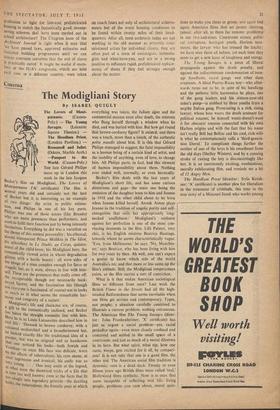Design
Lifting the Lid
By KENNETH J. ROBINSON thene roof. Both pavilions, according to the publicity handout, are miracles of conception, co-ordination and the generosity of manufac- turers—who lent materials or supplied them at cost price in return for nothing more than the most tremendous publicity.
The whole thing is a rather splendid example of the highly shoe-strung methods we are always obliged to use in order to tell other countries of our achievements. For once, I suppose, it was not a bad thing that we had to do things on the cheap, without government money, because the theme of the Congress is the influence of new methods of building on architecture, and Mr. Crosby's buildings are a useful demonstra- tion of prefabrication that is cheap and efficient without being dull. Even the art work, which is built in, is carried out in building materials such as Asbestolux (a relief mural by John Ernest) and plate-glass (decorated by Gillian Wise). 'Aren't you glad the Constructivists have found a Situation?' asked an art critic as I stubbed my toe on a heap of red-painted metal which looked as if it had fallen off the back of a lorry. 'Sculp- ture,' I read unbelievingly from my catalogue, `by Anthony Caro,' and hurried back to the sane, reassuring world of architects.
Comparatively sane, that is. The trouble with these congresses is that they really do lift the lid off the profession and leave you wondering what architects are for. Are they egocentrics, longing to experiment with new materials at their clients' expense, in a joyous aesthetic exercise? Are they solid, socially conscious members of the community? Do they ever agree about any- thing? I give a few examples from the Congress: POST-WAR HOUSING. 'It stands out on the whole as a fine architectural response to a social ser- vice': Sir William Ho!ford. 'Most of our housing is not representative of our architectural know- ledge. Housing has dragged along at a safe pedestrian level': Eric Lyons.
PRIVATE HOUSES. 'The designing of private houses by architects for individual clients is in- creasing': June Park. 'The heyday of the tailor- made house is past': Eric Lyons.
POST-WAR SCHOOLS. 'They have failed to de- velop an appropriate language': Peter Smithson. 'There are few that are rank bad bits of archi- tecture thanks to the establishment of a genuine schools vernacular': J. M. Richards.
ARCHITECTURAL HIGH JINKS. 'The days have already gone when architects felt it necessary to exploit the new scientifically produced materials and techniques as dramatically as pos- sible': The Times. 'The number of works of great structural daring will continually increase': Pier Luigi Nervi.
And so it goes on. Henry Russell Hitchcock, the American historian, spoke warmly at the Congress of the skyscraper housing by Mies van der Rohe. But Lewis Mumford, the American sociologist, who came over here to receive the Royal Gold Medal for architecture, said that van der Rohe's 'house dweller is selected as an astronaut is selected for a space capsule, so as to conform closely, both physically and psy- chologically, to the formalistic conditions and the financial calculations.' The Congress theme, 'New Materials and Techniques: Their Impact on Architecture,' has been interpreted in different ways by representatives of different countries. The more romantic have followed the Italian, Nervi, in his enthusiasm for prefabrication as a means of producing concrete forms that aid elegant and exciting; the socially realistic Eastern countries have followed the Polish architect Jerzy Hryniewiecki in his plea for mass-produc- tion of housing to match the mass-production of consumer goods, so that the world can get nearer to solving its slum problems. , Of course, we need the Nervis to give us beautiful (forgive the outmoded word) twentieth- century buildings—and I imagine we have half a dozen architects in our 20,000-strong profession who will produce some excellent prestige build- , ings in the next few years, But Hyrniewiecki's lecture made me realise that those of us who write about architecture are inclined to drive at high speeds through new towns or post-war housing estates registering noisy displeasure be- cause we are not `iesthetically satisfied' by ex- periments which have brought decent living conditions to thousands of people. Why is it so easy to forget that ten million people in this country are still living in slums? Are there not enough angry young men in the architectural ptofession to tight for low-cost preCabricated housing to match the fantastically good, money- saving schemes that have been carried out in school architecture? The Congress issue of the Architects' Journal is right when it says that we have passed laws, approved estimates and launched building programmes until we can almost convince ourselves that the evil of slums is practically cured. It might be useful if mem- bers ot the lUA's congresses, which are held ea:h time in a ditierent country, were taken on coach tours not only of architectural achieve- ments but of the worst housing conditions to be found within twenty miles of their head- quarters. After all, most architects today are not working in the old manner as privately com- missioned artists for individual clients; they are often part of a team of sociologists, technolo- gists and what-have-you, and are in a strong position to influence rapid, prefabricated replace- ments of slums if they feel strongly enough about the matter.



























































 Previous page
Previous page